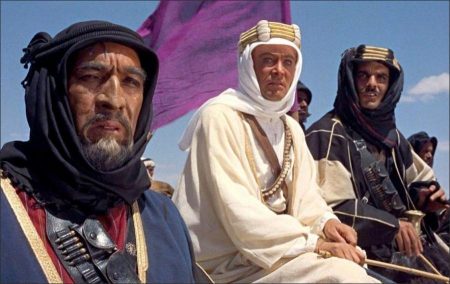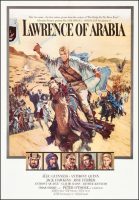Lawrence of Arabia movie storyline. An inordinately complex man who has been labeled everything from hero, to charlatan, to sadist, T.E. Lawrence blazed his way to glory in the Arabian desert, then sought anonymity as a common soldier under an assumed name.
The story opens with the death of Lawrence in a motorcycle accident in Dorset at the age of 46. Then flashbacks to recount his adventures: as a young intelligence officer in Cairo in 1916, he is given leave to investigate the progress of the Arab revolt against the Turks in World War I. In the desert, he organizes a guerrilla army and–for two years–leads the Arabs in harassing the Turks with desert raids, train-wrecking and camel attacks. Eventually, he leads his army northward and helps a British General destroy the power of the Ottoman Empire.
Lawrence of Arabia (1962) is the filmic retelling of Britishman T. E. Lawrence’s heroic, autobiographical account of his own Arabian adventure, published in “The Seven Pillars of Wisdom” (originally published with the title Revolt in the Desert). The cinematic “men’s film” (with first-time screenwriter Robert Bolt’s screenplay) is a superb character study of a compelling cult hero, who exhibits homo-erotic tendences in his relationship with Arab blood brother Sherif Ali (Omar Sharif), a dark personal nature, and an obsession with Arabia itself.
The beautiful masterpiece (accompanied by a superb score from Maurice Jarre) is thought by many to be director David Lean’s best (even topping The Bridge on the River Kwai (1957)), with its Super Panavision 70 mm scope, magnificent color cinematography and poetic imagery of the desert captured within a spectacular epic story of a larger-than-life, idealistic adventurer.
The Arabian desert functions as a majestic backdrop and metaphysical land for Lawrence’s exploits. Its two most famous shots and cinematographic images are the mirage shot – to announce the arrival of Sherif Ali, and the jump-cut from the burning match in Lawrence’s fingers to the rising desert sun. Lean admitted that almost all of the film’s movement was from left to right, to emphasize the journey theme of the film.
The film conveys the enigmatic, complex life and exploits of an eccentric, rebellious, desert-loving, messianic, Oxford-bred British Army officer / Welsh cartographer (repeatedly referred to as an “Englishman”), who unites the desert-dwelling Arabian Bedouins against the oppressive Turks (allies of Germany) during World War I. His extraordinary knowledge of the politics and culture of the Mideast allows him to organize the various, willful Arab tribes to repel enemies of the British.
Lawrence of Arabia (1962)
Directed by: David Lean
Starring: Peter O’Toole, Alec Guinness, Anthony Quinn, Jack Hawkins, Omar Sharif, José Ferrer, Anthony Quayle, Claude Rains, Arthur Kennedy, Donald Wolfit, Gamil Ratib, Michel Ray
Screenplay by: Robert Bolt
Production Design by: John Box
Cinematography by: Freddie Young
Film Editing by: Anne V. Coates
Costume Design by: Phyllis Dalton
Set Decoration by: Dario Simoni
Art Direction by: John Stoll, Anthony Masters
Music by: Maurice Jarre
Distributed by: Columbia Pictures
Release Date: December 10, 1962
Visits: 82

